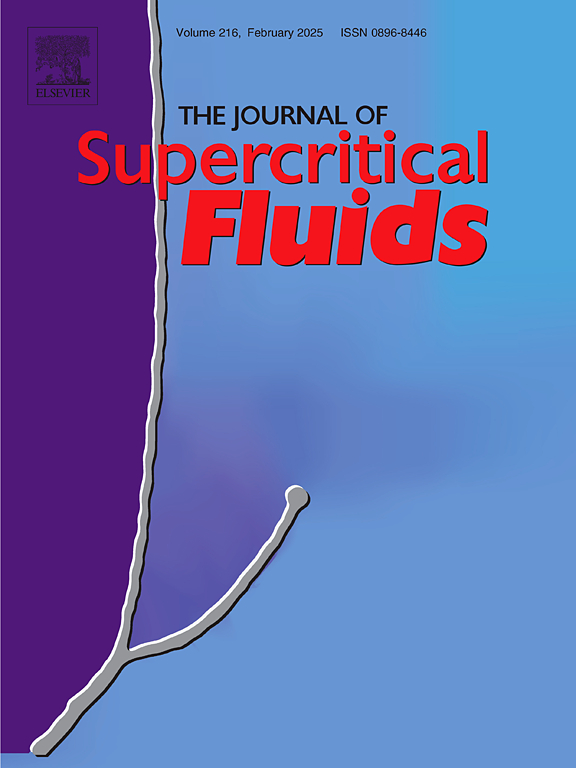Enhanced decolorization behaviors of colored PET textiles by supercritical carbon dioxide as part of the recycling process
IF 3.4
3区 工程技术
Q2 CHEMISTRY, PHYSICAL
引用次数: 0
Abstract
Currently, most colored Polyethylene terephthalate (PET) textiles are not recycled, because the presence of dyes leads to uncontrollable coloration in chemically recycled PET products. Traditional solvent-based decolorization faces scalability challenges due to high solvent use, low efficiency, and environmental impact. This study explores scCO₂ to enhance solvent decolorization by reducing PET-dye interactions. An scCO₂-assisted decolorization process was established in a batch reactor. Optimal conditions were identified at 8 MPa, 90 °C, and solid-to-liquid ratio of 1:20, enabling 86 % disperse dye removal within 20 min. Under higher energy consumption conditions (1 h, 120 °C), the single-cycle decolorization efficiency reached 97 %. Considering the liquid phase renewal in a continuous process, repeated decolorization of the treated PET enabled complete dye removal within three cycles. The kinetics were studied with activation energy calculated. Additionally, the process did not change the structure of stripping solvents and disperse dyes, allowing for subsequent recycling and reuse.
超临界二氧化碳作为回收过程的一部分,增强了有色PET纺织品的脱色行为
目前,大多数彩色聚对苯二甲酸乙二醇酯(PET)纺织品不能回收,因为染料的存在导致化学回收的PET产品无法控制着色。传统的溶剂型脱色由于溶剂用量大、效率低和对环境的影响而面临着可扩展性的挑战。本研究探讨了scCO₂通过减少pet -染料相互作用来增强溶剂脱色。在间歇式反应器中建立了scCO 2辅助脱色工艺。最佳条件为8 MPa, 90℃,料液比1:20,在20 min内分散染料去除率达到86% %。在较高的能耗条件下(1 h, 120℃),单周期脱色效率可达97 %。考虑到连续过程中的液相更新,处理后的PET重复脱色可以在三个周期内完全脱色。研究了反应动力学,计算了活化能。此外,该工艺不改变剥离溶剂和分散染料的结构,允许随后的回收和再利用。
本文章由计算机程序翻译,如有差异,请以英文原文为准。
求助全文
约1分钟内获得全文
求助全文
来源期刊

Journal of Supercritical Fluids
工程技术-工程:化工
CiteScore
7.60
自引率
10.30%
发文量
236
审稿时长
56 days
期刊介绍:
The Journal of Supercritical Fluids is an international journal devoted to the fundamental and applied aspects of supercritical fluids and processes. Its aim is to provide a focused platform for academic and industrial researchers to report their findings and to have ready access to the advances in this rapidly growing field. Its coverage is multidisciplinary and includes both basic and applied topics.
Thermodynamics and phase equilibria, reaction kinetics and rate processes, thermal and transport properties, and all topics related to processing such as separations (extraction, fractionation, purification, chromatography) nucleation and impregnation are within the scope. Accounts of specific engineering applications such as those encountered in food, fuel, natural products, minerals, pharmaceuticals and polymer industries are included. Topics related to high pressure equipment design, analytical techniques, sensors, and process control methodologies are also within the scope of the journal.
 求助内容:
求助内容: 应助结果提醒方式:
应助结果提醒方式:


